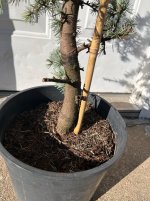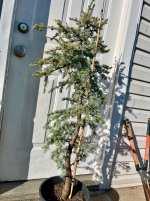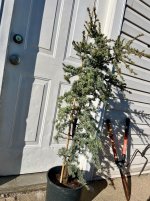Mike132327
Yamadori
I recently purchased this Blue Atlas Cedar. It was buried in among a few other cedars. This one had the most movement in the trunk and very full branches with low growth. All of the grafts looked about the same so I went with this one for the other features. I am making this post for advice on long term development of this tree.
I like the size of the tree currently (41” tall, 2” girth just above graft). I think I would like this to be about the finished height of the tree I would like to get the trunk in proportion with the height. I would like this to present as a big powerful tree like you would see in the mountains. I am hoping the graft area swells like I have seen on many other BAC as I’d prefer that over the inverse taper I have now. If it doesn’t I might try to just bury or ground layer it.
Should I trim the apical leaders back to new shoots post flush this spring? I am assuming that not cutting the tree back hard will help nutrition be balanced and help grow the trunk and increase back budding.
I have space to plant it in the ground which from my research is the consensus as the quickest way to increase trunk diameter as a general statement. However I have read that BAC don’t love having their roots worked on. Would ground planting make its eventual move back to a container a riskier maneuver?
I am not opposed to building a grow box where I can get it out of the ground every few years without disturbing the roots too much. Would this yield better results than continued up potting?
I plan to keep it in nutrient rich organic soil with a few amendments for drainage, and feeding it throughout the season while I am growing the trunk. I would guess this is an 8-10 year project to get it to start looking like what I see in my head. I am not in a rush to get this in a bonsai pot. I would prefer the best quality tree I can muster here however long it takes.
I know there were a ton of questions here and I hope I have given enough info on the tree, and my goal. What would be the next steps you’d take to start this tree on its journey?
I like the size of the tree currently (41” tall, 2” girth just above graft). I think I would like this to be about the finished height of the tree I would like to get the trunk in proportion with the height. I would like this to present as a big powerful tree like you would see in the mountains. I am hoping the graft area swells like I have seen on many other BAC as I’d prefer that over the inverse taper I have now. If it doesn’t I might try to just bury or ground layer it.
Should I trim the apical leaders back to new shoots post flush this spring? I am assuming that not cutting the tree back hard will help nutrition be balanced and help grow the trunk and increase back budding.
I have space to plant it in the ground which from my research is the consensus as the quickest way to increase trunk diameter as a general statement. However I have read that BAC don’t love having their roots worked on. Would ground planting make its eventual move back to a container a riskier maneuver?
I am not opposed to building a grow box where I can get it out of the ground every few years without disturbing the roots too much. Would this yield better results than continued up potting?
I plan to keep it in nutrient rich organic soil with a few amendments for drainage, and feeding it throughout the season while I am growing the trunk. I would guess this is an 8-10 year project to get it to start looking like what I see in my head. I am not in a rush to get this in a bonsai pot. I would prefer the best quality tree I can muster here however long it takes.
I know there were a ton of questions here and I hope I have given enough info on the tree, and my goal. What would be the next steps you’d take to start this tree on its journey?






